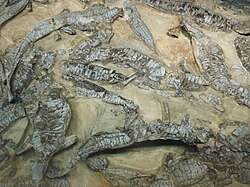Aetosaurus
|
Aetosaurus Temporal range: Late Triassic |
|
|---|---|
 |
|
| Assemblage of fossil A. ferratus | |
| Scientific classification | |
| Kingdom: | Animalia |
| Phylum: | Chordata |
| Class: | Reptilia |
| Order: | †Aetosauria |
| Family: | †Stagonolepididae |
| Subfamily: | †Aetosaurinae |
| Genus: |
†Aetosaurus Fraas, 1887 |
| Species | |
|
|
| Synonyms | |
|
|
Aetosaurus is an extinct genus of archosaur reptile belonging to the order Aetosauria. It is generally considered to be the most primitive aetosaur. Three species are currently recognized: A. ferratus, the type species from Germany and Italy;A. crassicauda from Germany; and A. arcuatus from eastern North America. Additional specimens referred to Aetosaurus have been found from South Africa, the Chinle Group of the southwestern United States, and the Fleming Fjord Formation of Greenland. Specimens of Aetosaurus occur in Norian-age strata.
Aetosaurus was a small, primitive aetosaur. Unlike more derived aetosaurs such as Desmatosuchus or Typothorax, the carapace was long and narrow and lacked spikes. The paramedian scutes that covered the back (with one row on each side of the vertebrae) are considerably wider than they are long. The lateral scutes, which are beneath the paramedians and formed a row on either side of the animal, do not bear any spikes or other projections.
Aetosaurus was first named, with the description of the type species A. ferratus, in 1877 by German paleontologist Oskar Fraas. At the time, Aetosaurus was known from 22 articulated skeletons that had been found in the Lower Stubensandtein of Germany. Thirty years later, Fraas' son Eberhard described a second species, A. crassicauda, also from Germany.A. crassicauda can be distinguished from A. ferratus by its larger size; A. crassicauda reached a maximum length of 150 centimetres (59 in) while A. ferratus reached a length of up to 90 centimetres (35 in).
...
Wikipedia
